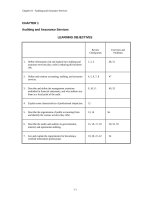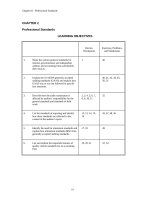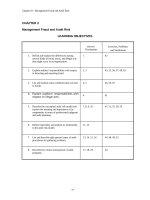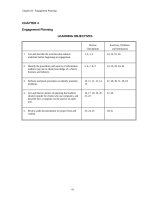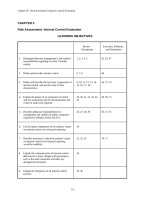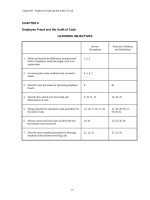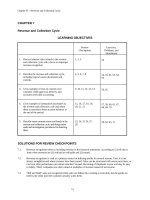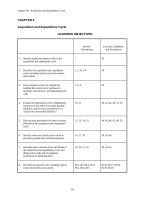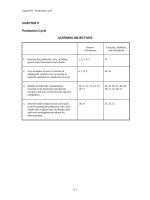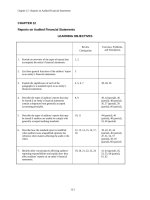Solution manual auditing and services 2e by louwers chap004
Bạn đang xem bản rút gọn của tài liệu. Xem và tải ngay bản đầy đủ của tài liệu tại đây (599.21 KB, 40 trang )
Chapter 04 - Engagement Planning
CHAPTER 4
Engagement Planning
LEARNING OBJECTIVES
Review
Checkpoints
Exercises, Problems
and Simulations
1.
List and describe the activities that auditors
undertake before beginning an engagement.
1, 2, 3, 4
53, 54, 55, 65
2.
Identify the procedures and sources of information
auditors may use to obtain knowledge of a client’s
business and industry.
5, 6, 7, 8, 9
52, 56, 59, 63, 64
3.
Perform analytical procedures to identify potential
problems.
10, 11, 12, 13, 14,
15
47, 48, 49, 51, 58, 62
4.
List and discuss matters of planning that auditors
should consider for clients who use computers, and
describe how a computer can be used as an audit
tool.
16, 17, 18, 19, 20,
21, 22
57, 60
5.
Review audit documentation for proper form and
content.
23, 24, 25
50, 61
4-1
Chapter 04 - Engagement Planning
SOLUTIONS FOR REVIEW CHECKPOINTS
4.1
Auditors can use the following sources of information to help decide whether to accept a new audit
client.
Financial information prepared by the prospective client:
Annual reports to shareholders
Interim financial statements
Securities registration statements
Annual report on SEC Form 10-K
Reports to regulatory agencies
Inquiries directed to the prospect’s business associates:
Banker
Legal counsel
Underwriter
Other persons, e.g., customers, suppliers
Predecessor auditor, if any, communication, re:
Integrity of management, Disagreements with management
Analysis:
Special or unusual risk related to the prospect
Need for special skills (e.g., computer or industry expertise)
Internal search for relationships that would compromise independence
Auditors can search business press articles and stories and legal files on the Lexis-Nexis system or
on the Internet for news about chairman of the board, the CEO, the CFO, and oftentimes other
high-ranking officers. Auditors can engage an outside search firm (private investigators) to conduct
additional searches for information. Auditors are looking for information about client risk factors-companies accused of fraud, companies under SEC or other regulatory investigation, companies
that have changed auditors frequently, and companies showing recent losses.
4.2
Client consent is required because the Code of Professional Conduct prohibits the predecessor
audit firm from revealing confidential information to the successor audit firm without the consent.
Confidentiality remains even when the auditor-client relationship ends.
A successor audit firm should inquire specifically about:
Management’s integrity
Disagreements the predecessor may have had with management about accounting principles
and audit procedures.
Communications the predecessor gave the former client about fraud, illegal acts, and internal
control recommendations.
The predecessor’s understanding about the reasons for the change of auditors (particularly
about the predecessor’s termination).
4-2
Chapter 04 - Engagement Planning
4.3
Engagement letter benefits:
Helps establish an understanding between client and public accounting firm of the terms of
the engagement and the nature of the work.
Helps avoid quarrels and misunderstandings between client and auditor.
Helps avoid disputes over the audit fee.
Helps avoid legal liability assertions based on failure to do work that the CPA may not have
contemplated or agreed to do.
A termination letter is a letter from a former public accounting firm (fired or resigned) to a former
client specifying terms for future services and the auditors’ understanding of the circumstances of
termination.
4.4
Persons and skills normally assigned to a “full service” audit team:
Audit personnel:
Engagement partner
Second (concurring) audit partner
Audit manager
Senior accountant(s)
Statistical auditing specialist, if needed
Computer auditing specialist, if needed
Industry specialist, if needed
Tax partner
4.5
Methods and sources of information for understanding a client’s business and industry:
Inquiry, including review of prior year audit documentation--personnel who worked on the audit in
prior years are available to convey their understanding of the business, inquiry and interviews with
the company’s management, directors, and audit committee.
Observation--take a tour of the company’s physical facilities, keeping eyes open for activities and
things that should be reflected in the accounting records. The tour is the time to see company
personnel in their normal workplaces.
Study numerous sources--AICPA industry accounting and auditing guides, specialized trade
magazines and journals, registration statements and 10-K reports filed with the SEC, general
business magazines and newspapers (Business Week, Forbes, Fortune, Harvard Business Review,
Barron’s, and The Wall street Journal).
4.6
Find information about real estate valuation (tax appraisal) in the city and county tax
assessor-collector files. About aircraft ownership from the Federal Aviation Administration. Names
of licensed doctors in the state medical society directory. Assumed business names in the state or
county assumed named registry. Liens on personal property in the UCC documents filed, by
borrower name, in the county clerk or State’s Secretary of State or commercial department office.
4.7
The problem with evidence obtained from related parties is that the source is potentially biased,
and the information may be self-serving and misleading.
4-3
Chapter 04 - Engagement Planning
4.8
Benefits of preliminary assessment of materiality:
Fine-tune the audit for effectiveness and efficiency.
Help auditors avoid surprises related to:
Finding out too late about not auditing enough.
Finding out later about auditing too much.
4.9
Prior to using internal auditors, external auditors should consider internal auditors’ objectivity and
competence.
4.10
The purpose of performing preliminary analytical procedures in the audit planning stage is to
direct attention to potential problem areas so the audit work can be planned to reduce the risk of
missing something important.
4.11
The steps auditors can use to apply comparison and ratio analysis to unaudited financial statements
are: (1) develop an expectation, (2) define a significant difference, (3) calculate predictions and
compare them with the recorded amount, (4) investigate significant differences, and (5) document
each of the above steps.
4.12
The ratios in Appendix 4.A are: current ratio, days’ sales in receivables, doubtful accounts ratio,
days’ sales in inventory, receivables turnover, inventory turnover, cost of goods sold ratio, return
on equity, and Altman’s financial distress ratios and discriminant score. Students may be able to
name other relevant ratios.
4.13
Analytical procedures are required (1) at the beginning of an audit—the planning stage application
of analytical procedures discussed in this chapter and (2) at the end of an audit when the partners
in charge review the overall quality of the work and look for apparent problems. They are
optional as substantive audit procedures.
4.14
A planning memo summarizes all the important overall planning information and documents that
the audit team is following generally accepted auditing standards. The memo becomes a basis for
preparing the audit program.
4.15
Auditors usually prepare a planning memorandum summarizing the preliminary analytical
procedures and the materiality assessment with specific directions about the effect on the audit.
This planning memo also usually includes information about:
(1) Investigation or review of the prospective or continuing client relationship.
(2) Provision of special services or reports and needs for special technical or industry expertise.
(3) Staff assignment and timing schedules.
(4) The assessed level of control risk.
(5) Significant industry or company risks.
(6) Computer system control environment.
(7) Utilization of the company’s internal auditors.
(8) Identification of unusual accounting principles problems.
(9) Schedules of work periods, meeting dates with client personnel, and completion dates.
4.16
General characteristics of transactions that are typically computerized: Frequent, repetitive, large
number.
General characteristics of transactions that typically are not computerized: Infrequent, occasional,
small number.
4-4
Chapter 04 - Engagement Planning
4.17
The “audit trail” (sometimes called “management trail” as it is used more in daily operations than
by auditors) is the source documents, journal postings and ledger account postings maintained by a
client in order to keep books. These are a “trail” of the bookkeeping (transaction data processing)
that allow auditors to follow the sequence of processing on (or because of) a transaction with a
tracing or vouching procedures.
In a manual system this “trail” is usually visible to the eye with posting references in the journal
and ledger and hard-copy documents in files. But in a computer system, the audit trail in
advanced systems may not be in a human-readable form and may exist for only a fraction of a
second. Further, the posting references may not exist, and the records must be read using the
computer rather than the naked eye. Most systems still have hard-copy papers for basic
documentation, but in some advanced systems even these might be absent.
There are several control implications of an electronic audit trail. The first implication is that
concern for an audit trail needs to be recognized at the time a system is designed. Techniques such
as integrated test facility, audit files and extended records must be specified to the systems
designer. The second control implication is that if the audit trail exists only momentarily in the
form of transaction logs or master records before destructive update, the audit team must review
and evaluate the transaction flow at various times throughout the processing period. Alternatively,
the audit team can rely more extensively on internal auditors to monitor the audit trail.
4.18
The important differences between manual and computer accounting systems are in these areas:
(1) transaction trails, (2) uniform processing of transactions, (3) separation of functions, (4)
potential for errors and frauds, (5) potential for increased management supervisions, and (6)
initiation or subsequent execution of transactions by computer.
4.19
Additional planning considerations when computer processing is involved are:
The extent to which the computer is used in each significant accounting application.
The complexity of the computer operations used by the entity, including the use of an
outside service center.
The organizational structure of the computer processing activities.
The availability of data.
The computer-assisted audit techniques to increase the efficiency of audit procedures.
The need for specialized skills.
4.20
Computer assisted audit techniques (CAATs) collectively is a set of preprogrammed editing,
operating, and output routines that can be called into use with a simple, limited set of
programming instructions by an auditor who has one or two weeks intensive training.
4.21
Six audit procedures that can be performed using CAATs software are:
1.
2.
3.
4.
5.
6.
Recalculation.
Confirmation.
Document Examination (limited).
Scanning.
Analytical Procedures.
Fraud Investigation.
4-5
Chapter 04 - Engagement Planning
4.22
Advantages of using CAATs to perform recalculations are primarily speed and accuracy. With
CAATS it is just as easy to recalculate all client computations as it would be to test a sample of
calculations. Any differences from client computations can be printed out for investigation.
When using CAATs to select samples and print confirmations, the advantages include the use of
preprogrammed statistical routines to randomly select the sample and the speed with which
confirmations can be prepared on preprinted forms.
4.23
a.
In the permanent audit file:
1.
2.
3.
4.
5.
6.
b.
Copies or excerpts of the corporate or association charter, bylaws, or partnership
agreement.
Copies or excerpts of continuing contracts such as leases, bond indentures, and
royalty agreements.
A history of the company, its products, markets and background.
Copies or excerpts of stockholders, directors, and committee minutes on matters
of lasting interest.
Continuing schedules of accounts whose balances are carried forward for several
years, such as owners’ equity, retained earnings, partnership capital and the like.
Copies of prior years’ financial statements and audit reports.
In the front of the current working paper file.
1.
2.
3.
4.
5.
6.
7.
8.
9.
10.
11.
12.
13.
14.
15.
16.
17.
18.
Engagement letter.
Staff assignments.
Client organization chart.
Memoranda of conferences with management.
Memoranda of conferences with the director’s audit committee
Preliminary analytical review notes.
Initial risk assessment notes.
Initial materiality assessment notes.
Engagement planning memorandum
Audit engagement time budget.
Internal control questionnaire and control analyses.
Management controls questionnaire.
Computer control questionnaire.
Internal control system flow charts.
Audit programs.
A working trial balance of general ledger accounts.
Audit documentation of preliminary adjusting and reclassifying entries.
Memoranda of review notes and unfinished procedures (all cleared by the end of
the fieldwork.)
4.24
The most important facet of the current audit documentation files is the requirement that they
show the audit decision problems and their conclusions. These papers must record the proposition
to be audited, the evidence gathered, and the final decision. The documentation should
demonstrate satisfaction of the standards of fieldwork and provide support for the audit report.
4.25
Word processing can be used in an audit to prepare audit programs, write audit memoranda, and
write audit reports. A computer electronic spreadsheet can be used instead of paper and pencil to
create the form of a bank reconciliation, with space provided for text lists of outstanding items
(using the label input capability), and math formulas inserted for accurate arithmetic in the
reconciliation. Printing such a reconciliation is easy (and much prettier than most accountants’
handwriting!).
4-6
Chapter 04 - Engagement Planning
SOLUTIONS FOR MULTIPLE-CHOICE QUESTIONS
4.26
a.
b.
c.
Incorrect.
Incorrect.
Correct.
d.
Incorrect.
a.
Incorrect.
b.
c.
d.
Correct.
Incorrect.
Incorrect.
a.
Incorrect.
b.
Correct.
c.
Incorrect.
d.
Incorrect.
4.29
d.
Correct.
(All of the above). Analytical procedures can be used when planning
the audit, when performing substantive procedures during an audit, and
as a method of overall review at the end of an audit.
4.30
a.
Incorrect.
b.
Incorrect.
c.
Incorrect.
d.
Correct.
Weaknesses in the company’s internal control are not a subject for
preliminary analytical procedures because auditors can’t examine the
internal controls at this particular time with these kinds of analyses.
Individual transactions are not used in preliminary analytical
procedures.
Management assertions in financial statements are not the direct object
of preliminary attention-directing analytical procedures.
With preliminary analytical procedures, the auditors are looking for
signs of accounts and relationships that may represent specific potential
problems and risks in the financial statements.
a.
True.
b.
c.
True.
True.
d.
Correct.
4.27
4.28
4.31
Confirmation is not an analytical procedure.
Physical observation is not an analytical procedure.
Analytical procedures incorporate information from a variety of
sources.
Tests of details are not analytical procedures.
Analytical procedures are performed after the engagement letter is
obtained.
This is the “attention-directing” purpose.
All the assertions are always important.
This answer could be good even though it evokes the control risk
assessment standard, but restriction to inventory makes it a poor choice.
Physical production statistics are not a source of information for
“comparison of current account balances with prior periods.”
A client’s budgets and forecasts are sources of information for
“comparison of current account balances with expected balances.”
Published industry ratios are not a source of information for
“evaluation of current account balances with relation to predictable
historical patterns.”
The company’s own historical financial statements are not a good
source of information for “evaluation of current account balances in
relation to nonfinancial information.”
The successor must take responsibility for obtaining the client’s consent
for the predecessor to give information about prior audits.
Cooperation from the predecessor is expected.
Cooperation includes obtaining copies of some or all of the predecessor
auditors’ documentation.
All of the above are expected.
4-7
Chapter 04 - Engagement Planning
4.32
4.33
4.34
4.35
4.36
4.37
4.38
a.
Incorrect.
b.
c.
d.
Incorrect.
Correct.
Incorrect.
a.
Incorrect.
b.
c.
d.
Incorrect.
Correct.
Incorrect.
a.
b.
c.
Correct.
Incorrect.
Incorrect.
d.
Incorrect.
a.
Incorrect.
b.
Incorrect.
c.
Incorrect.
d.
Correct.
a.
Incorrect.
b.
Incorrect.
c.
Correct.
d.
Incorrect.
a.
Incorrect.
b.
c.
Incorrect.
Correct.
d.
Incorrect.
a.
b.
c.
d.
Incorrect.
Correct.
Incorrect.
Incorrect.
Although strongly encouraged, U.S. GAAS do not require a written
engagement letter for audits.
Client consents do not have to be in writing.
A written audit program is required (SAS 22, AU 311).
Written time budgets and schedules may be a good idea but they are not
required.
Audit documentation is necessary to document compliance with
GAAS.
Extracts of contracts should go in the permanent file.
Independence is not really a working paper matter.
Materiality judgments will affect the amount of evidence shown in
audit documentation.
Evidence bears on the year under audit.
Current-year evidence is usually not in the permanent file.
The administrative audit documentation do not contain current-year
evidence about particular balances.
The planning memo does not contain evidence.
Internal control analysis for the current year would be in the
administrative or current file.
The latest engagement letter would be in the administrative or current
file.
Memoranda of conference with management would be in the
administrative or current file.
Excerpts of the corporate charter and by-laws would not change often
and would be in the permanent file.
Materiality determination helps concentrate the audit work where it is
most needed.
Materiality determination helps auditors to do the “sufficient” amount
of work.
The kind of opinion cannot be determined until all the evidence is
obtained and evaluated.
Materiality determination helps auditors to do the “sufficient” amount
of work.
Spreadsheet software would not be appropriate for testing internal
controls over computerized accounting applications.
Word processing software would be best to prepare an audit program.
Spreadsheet software is ideal for preparing a comparison of current
year expenses with those from the previous year.
Word processing software would be best for drafting a planning memo.
All CAATs are not in the same language.
CAATs can be transported to various clients having various systems.
Input controls are important in their own right.
The use is the means to accomplish testing, but the complete set of
audit procedures can rarely be done entirely on the computer.
4-8
Chapter 04 - Engagement Planning
4.39
a.
b.
c.
d.
Incorrect.
Correct.
Incorrect.
Incorrect.
These are functions of a client’s computer system.
Auditors can use the computer with ease.
Machine operations do not leave “visible” evidence.
Computer auditing is meant to gather good evidence with the least
quantity of storage.
4.40
a.
b.
Incorrect.
Correct.
c.
Incorrect.
The ratio of cost/sales does not increase.
The numerator (cost of goods sold) increases relatively less than the
denominator (sales) increases.
The ratio of cost/sales does not remain unchanged.
a.
b.
c.
Correct.
Incorrect.
Incorrect.
d.
Incorrect.
a.
Incorrect.
b.
Correct.
c.
Incorrect.
d.
Incorrect.
a.
Incorrect.
b.
Incorrect.
c.
Incorrect.
d.
Correct.
4.41
4.42
4.43
Client cooperation should be specified.
Technical details are not in the engagement letter.
Litigation matters are covered with respect to the request for an
attorney’s letter.
Client representations about board minutes should be in the client’s
written representation letter.
The auditors’ report should not mention the fact that a specialist was used,
unless the specialist’s findings affect the auditors’ conclusions.
The auditors’ report should only mention the use of the specialist when
the specialist’s findings affect the auditors’ conclusions.
The auditors’ report need not mention the use of a specialist if the
auditors decide not to take responsibility for the specialist’s findings.
The auditors’ report should only mention the specialist if Vandalay does
not agree with the specialist’s findings, resulting in an opinion other
than unqualified.
Interviewing internal auditors about their reporting responsibilities
would assist the audit team in determining whether the internal auditors
were objective, but would provide little evidence of related-party
transactions.
Reviewing accounting records for nonrecurring transactions occurring
throughout the year would raise suspicions of fraud, but not necessarily
related-party transactions.
Inspecting communications with the client’s legal counsel regarding
recorded contingent liabilities would be helpful in determining
contingent liabilities.
Scanning the minutes for significant transactions with members of the
Board of Directors would be helpful in identifying transactions with
parties related to the client.
4-9
Chapter 04 - Engagement Planning
4.44
4.45
4.46
a.
Incorrect.
b.
Incorrect.
c.
Incorrect.
d.
Correct.
a.
Incorrect.
b.
Incorrect.
c.
Incorrect.
d.
Correct.
d.
Correct.
A report to the audit committee on the results of testing of internal
control over cash receipts would typically occur after the entire period
could be tested, and therefore would be written after the balance sheet
date.
Confirmation letters to vendors confirming the amounts they owe to the
client are part of substantive procedures performed on balance sheet
account amounts.
An attorney’s letter regarding contingent liabilities would be written as
close to the end of fieldwork as practicable.
An engagement letter would be written before accepting an
engagement, and therefore before the balance sheet date.
Surprise counts of the client’s petty cash fund may occur during
planning, but are more typically performed close to the balance sheet
date.
Reporting internal control deficiencies to the audit committee would
typically occur after internal control testing was complete.
Performing a search for unrecorded liabilities would be performed as a
substantive procedure after planning.
Identifying related parties is an important part of planning.
Prior to accepting a new audit engagement, an audit firm should (a)
attempt to contact the predecessor auditor, (b) evaluate the integrity of
management, and (c) assess the firm’s resources.
4-10
Chapter 04 - Engagement Planning
SOLUTIONS FOR EXERCISES, PROBLEMS, AND SIMULATIONS
4.47
Analytical Procedures
Majestic appears to be:
1.
A large hotel (200 rooms versus 148)
2.
that charges slightly more than the average rate ($160 versus $120)
3.
and does not promote room occupancy too heavily (2.7% advertising versus 3.2%)
4.
hence its occupancy--paying guests--is not especially high (62.6% versus 68.1%),
although this occupancy rate represents more average rooms per day (125 = 62.6% x 200)
than the industry (101 = 68.1% x 148).
Majestic also appears to:
1.
Derive relatively more revenue from food and beverages (35.7%) than the industry
(32.3%)
2.
Be more lavish in providing food and beverages
Cost of food sold (42.1% versus 37.0%)
Cost of beverages sold (43.6% versus 29.5%)
Service--wages (39.6% versus 32.8%)
Memorandum--good working paper style
Index AP 7
____JR____
Prepared by
Date____1-15-0
X_______
Majestic Hotel
Preliminary Program Memorandum
Analysis of Statistics
FYE 3/31/09
Analysis of the operating statistics in working paper AP-6 indicates that the following may be
indicative of areas in the accounts where potential errors or frauds or other matters of audit
concern may exist. These should be covered in our preliminary planning of the audit program.
1.
Room sales revenue is not up to the industry average ratio. Revenues may not be
recorded properly--either not recorded or misclassified as food and beverage sales.
2.
Management fees appear considerably higher than the industry average. Expenses may
be misclassified or a related party transaction may be involved.
3.
Utilities, repairs, and maintenance appear to be higher than the industry average. Some
capitalizable expenditures may have been improperly classified as current expenses.
4.
Salaries and wages in both the rooms department and the food and beverages department
appear to be high. The problem may be more employees than average, padded payrolls,
or wage rates higher than average.
5.
The cost of food and beverages sold appears to be much higher than the industry average.
This could be due to payment of higher unit prices (presumably for higher quality), use of
greater quantities per serving, inventory pilferage, or erroneous inventory counts and
pricing.
4-11
Chapter 04 - Engagement Planning
4.48
Audit Simulation: Preliminary Analytical Procedures
E X H I B I T 4.48–2
ALPHA.COM, INC.
PRELIMINARY ANALYTICAL PROCEDURES DATA
COMPARATIVE, COMMONSIZE FINANCIAL STATEMENTS
Prior Year
(Audited)
Current Year
(Unaudited)
Change
Balance
Common
Size
Balance
Common
Size
Amount
Percent
Change
$9,000,000
100.00%
$9,720,000
100.00%
$ 720,000
8.00%
Cost of goods
sold
6,296,000
69.96
7,000,000
72.02
704,000
11.18
Gross margin
2,704,000
30.04%
2,720,000
27.98%
16,000
0.59%
General
expense
2,044,000
22.71
$2,003,000
20.61
(41,000)
–2.01
300,000
3.33
334,000
3.44
34,000
11.33
$360,000
4.00%
$383,000
3.94%
$23,000
6.39%
60,000
0.67
75,000
0.77
15,000
25.00
120,000
1.33
123,200
1.27
3,200
2.67
$180,000
2.00%
$184,800
1.90%
$4,800
2.67%
$600,000
14.78%
690,800
12.52%
90,800
15.13%
500,000
12.32
900,000
16.31
400,000
80.00
REVENUE
AND
EXPENSE:
Sales (net)
Depreciation
Operating
income
Interest
expense
Income taxes
(40%)
Net income
ASSETS:
Cash
Accounts
receivable
4-12
Chapter 04 - Engagement Planning
Allowance
doubtful
accounts
(40,000)
–0.99
(90,000)
–1.63
(50,000)
125.00
Inventory
1,500,000
36.95
1,350,000
24.47
(150,000)
–10.00
$2,560,000
63.05%
$2,850,800
51.67%
$290,800
11.36%
Fixed assets
3,000,000
73.89
4,500,000
81.57
1,500,000
50.00
Accum
depreciation
(1,500,000
)
–36.95
(1,834,000)
–33.24
(334,000)
22.27
Total assets
$4,060,000
100.00%
$5,516,800
100.00%
$1,456,80
0
35.88%
$450,000
11.08%
$330,000
5.98%
($120,000)
–
26.67%
0
0.00
1,750,000
31.72
1,750,000
Accrued
interest
60,000
1.48
40,000
0.73
(20,000)
–33.33
Accruals and
other
50,000
1.23
32,000
0.58
(18,000)
–36.00
Total current
assets
LIABILITIES
AND
EQUITY:
Accounts
payable
Bank loans,
8%
4-13
